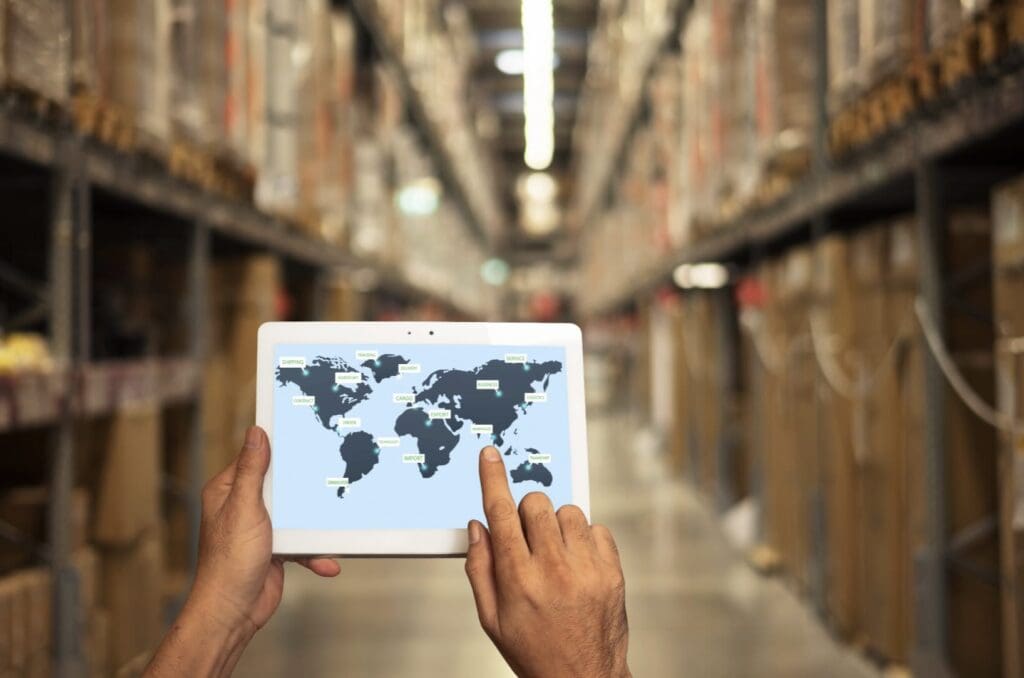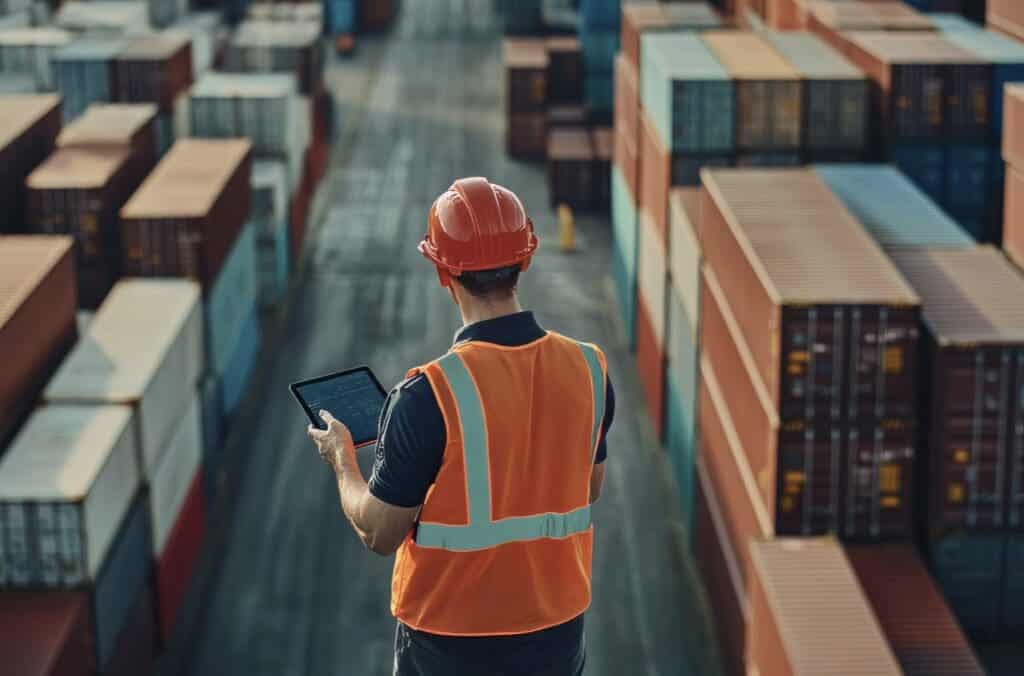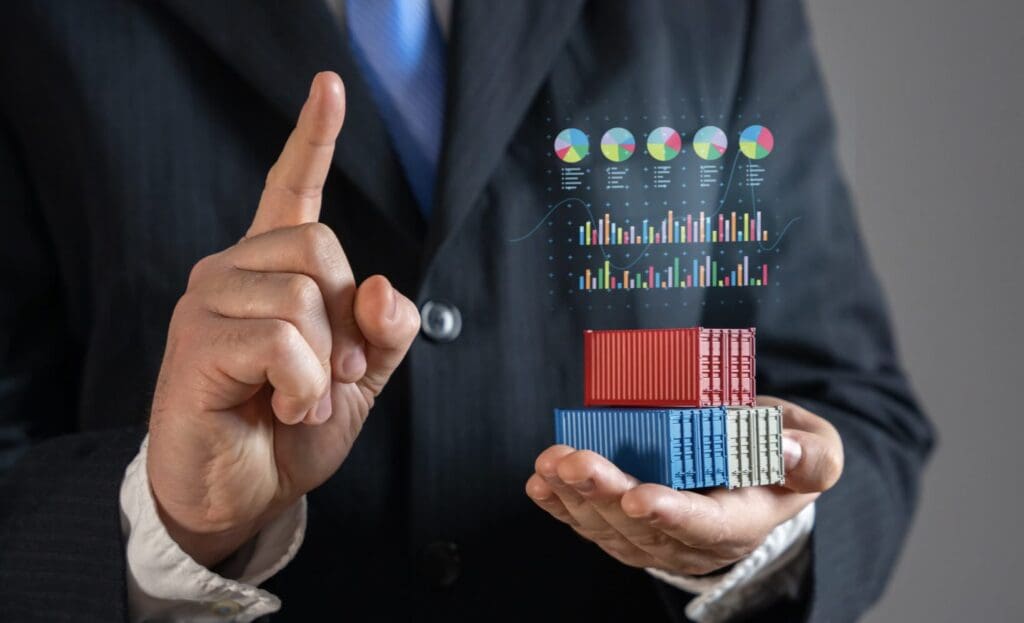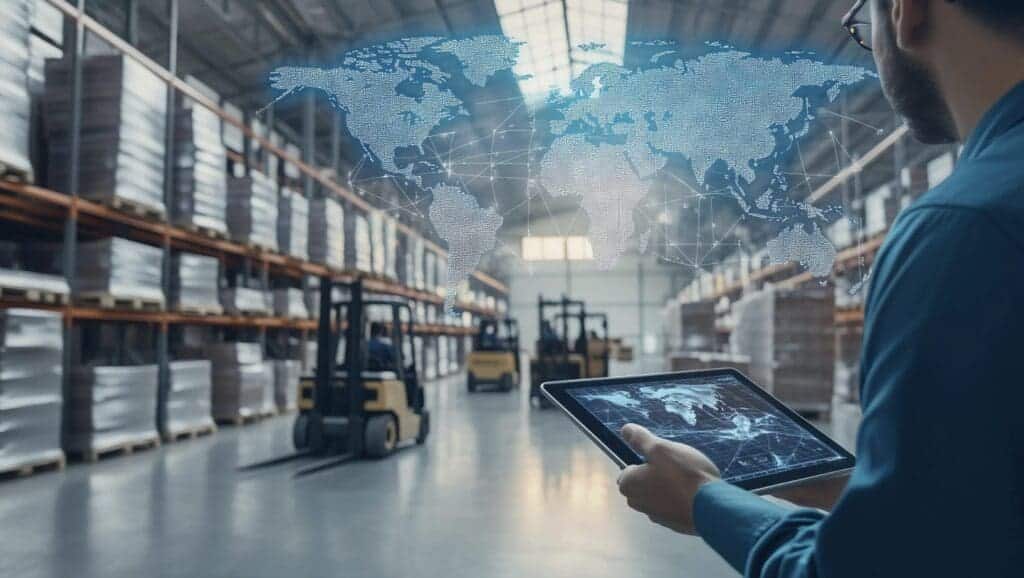Have you ever thought about how your favorite pair of sneakers made it to your doorstep from half a world away or how supermarkets are always stocked with fresh fruits, no matter the season? Well, friends, that’s all thanks to the magic of global supply chain management. This nifty system is like the ultimate relay race, passing products from country to country until they reach your hands.
We’ll dive into the basics, peek at the tech tools making things run smoother, and even discuss why it matters that this huge process keeps its green promises. Fasten your seatbelts—we’re about to take a whirlwind tour of the global supply chain highway!
Table of Contents
- Basics of Global Supply Chain Management
- Challenges and Solutions in the Global Supply Chain
- Rising Costs and Expense Management
- Regulatory Compliance Across Borders
- Sustainability and Ethical Considerations
- Talent Acquisition and Workforce Development
- Technological Advancements and Integration
- Natural Disasters and Global Crises
- Customer Expectations and Service Levels
- Risk Management and Contingency Planning
- Competition and Market Positioning
- Technology’s Role in the Global Supply Chain
- Real-Time Tracking and Visibility
- Predictive Analytics and Big Data
- Blockchain for Supply Chain Integrity
- Internet of Things (IoT) Paves the Way for Automation
- Cloud-Based SCM Platforms
- Artificial Intelligence (AI) for Decision-Making
- 3D Printing for On-Demand Manufacturing
- Drones and Autonomous Vehicles
- Sustainability and Ethics in Supply Chains
- The Future and Evolution of Global Supply Chains
- Related Content
Basics of Global Supply Chain Management
Deciphering the ABCs of Global Supply Chain Management
In the bustling world of global commerce, mastering the ABCs of supply chain management is like finding a treasure map that leads to a chest of efficiency and profit. It’s not just about moving products; it’s about crafting a slick, cost-effective path from the factory floor to the customer’s door. Let’s break down these essentials and why they matter.
A is for Agility: Be Quick on Your Feet!
Agility is your golden ticket in supply chain management. It’s all about how fast you can zig while others zag. Think of it as a supply chain ninja, slicing through red tape and responding like lightning to market swings or crises. You wanna ship those widgets post-haste when demand spikes! Agility means staying ahead of the game, forecasting like a pro, and never getting caught off guard.
B is for Breadth: Cover Your Bases!
Breadth is about having options as vast as the ocean. Your supply chain should be like a well-stocked tool belt, ready for any job. It’s having a lineup of suppliers and shipping routes ready so you’re never left in a lurch if a storm hits or a factory stalls. A vast network means flexing your logistical muscles to keep cargo flowing, no matter what Mother Nature or global politics throws your way.
C is for Collaboration: Let’s Work Together!
Collaboration? It’s the heart of the supply chain beat! Imagine a symphony where every instrument is out of sync – pure chaos, right? Picture a supply chain where communication zips back and forth without a hitch. That’s collaboration! Sharing data, goals, and chocolate chip cookies (okay, maybe not the cookies) with your partners ensures everyone’s paddling in rhythm, making the supply chain glide like a smooth kayak on a calm river.
Connecting the ABCs
Linking agility, breadth, and collaboration unlocks the global supply chain management puzzle. Companies that dance to this ABC tune can leap over logistical hurdles, forge through storms of uncertainty, and tap into global markets with the finesse of a world-class ballerina. It’s about being dynamic, prepared, and as connected as a spider’s web shimmering with morning dew.
So there you have it – the ABCs of supply chain management that can turn logistical lemons into lemonade, the tart kind that keeps customers returning for more. Get these down pat, and your supply chain might become the eighth wonder of the business world! Keep hustling, and remember, in the land of supply chains, those who master the ABCs reign supreme.

Challenges and Solutions in the Global Supply Chain
Cybersecurity concerns keep supply chain managers awake, as threats pose significant risks to data integrity and continuity of operations. With hackers becoming more sophisticated, preventing breaches that could compromise sensitive information is paramount.
Rising Costs and Expense Management
Supply chain managers must be savvy about cost management as materials, labor, and transportation expenses climb. Balancing quality against cost and maintaining profitability without compromising efficiency requires constant attention and strategy.
Regulatory Compliance Across Borders
Compliance with international trade regulations is a headache for supply chain professionals. Managers must stay informed about changing policies, import/export controls, and taxation laws to avoid fines and delays that could interrupt the supply chain and affect the bottom line.
Sustainability and Ethical Considerations
Sustainability efforts are no longer optional. Consumers and governments demand ethical sourcing and greener supply chains. Managers must integrate sustainable practices, from reducing carbon footprint to ensuring labor rights, throughout the supply chain, necessitating innovation and sometimes investment.
Talent Acquisition and Workforce Development
The hunt for skilled supply chain professionals is ongoing. Managers must attract, train, and retain talent capable of navigating the complexities of modern supply chains, often competing against a host of other industries for the best candidates.
Technological Advancements and Integration
Keeping up with technology, from IoT devices to AI analytics, is a game-changer in supply chain management. Managers must decide which technologies to invest in and how to integrate them into existing systems to enhance visibility, efficiency, and responsiveness.
Natural Disasters and Global Crises
Natural disasters, pandemics, and political unrest can dramatically disrupt supply chains. These scenarios test a manager’s ability to respond quickly, enact contingency plans, and ensure supply chain resilience in the face of unforeseen challenges.
Customer Expectations and Service Levels
Customers expect faster, more transparent, and more customized service. Meeting these demands often requires supply chain managers to overhaul traditional models, leverage technologies like blockchain for traceability, and ensure that the end-to-end supply chain is customer-centric.
Risk Management and Contingency Planning
Effective risk management is critical. Proactively identifying potential disruptions and forming robust contingency plans can be the difference between a supply chain that bends versus one that breaks under pressure.
Competition and Market Positioning
Maintaining a competitive edge is vital in today’s cutthroat market. Managers must ensure the supply chain operates like a well-oiled machine, strategically position their company against competitors, and adapt to shifting market demands.
Supply chain management can seem like a Herculean task with these worries looming large. The profession relies on foresight, agility, and a deep understanding of the global market’s intricate web. Despite the challenges, those at the helm of supply chains know that their ability to anticipate and navigate these issues provides peace of mind and builds resilient and successful businesses capable of withstanding the tests of tomorrow’s uncertainty.

Technology’s Role in the Global Supply Chain
Technology has been a game-changer in supply chain management (SCM) in recent years, transforming operations into a more efficient, transparent, and resilient part of business. Today’s tech advancements are not just about speed; they’re about more intelligent, interconnected systems that have the power to drastically improve how products move from point A to point B.
Real-Time Tracking and Visibility
Imagine monitoring your product’s journey every step, from manufacturing to the final destination. That’s precisely what real-time tracking technology is doing for SCM. It’s like having a tracking number for your package but on steroids. Sensors, GPS, and RFID tags provide a minute-by-minute update on location, temperature, handling conditions, and even the estimated arrival time. This level of detail ensures everyone involved can react quickly to unexpected changes, ensuring that products arrive as promised, every time.
Predictive Analytics and Big Data
Forgive the math-y sound of ‘predictive analytics,’ but this is one cool tech trend. Supply chain managers can use big data to predict future trends and market demands by analyzing vast amounts of information. Think of it as a crystal ball powered by data. By identifying patterns and potential problems before they occur, companies can make strategic decisions, reduce waste, and optimize inventory levels. The result? A leaner, meaner supply chain anticipates what customers want almost before they know themselves.
Blockchain for Supply Chain Integrity
Blockchain might be associated with cryptocurrency but has also found a valuable place in SCM. Blockchain technology boosts transparency across the supply chain by creating a permanent, tamper-proof ledger of every transaction. This means every product has a verified story that can be traced back to its origins, which is essential for food safety or ethical sourcing. In this way, blockchain builds consumer trust and enables companies to confidently assure their products’ integrity.
Internet of Things (IoT) Paves the Way for Automation
IoT is about connecting devices to the internet, but in SCM, it’s so much more. It’s about machines talking to each other in a meaningful way. For example, a sensor on a delivery truck can alert a warehouse that it’s running late, and the warehouse’s automated systems can adjust schedules on the fly. This tech-driven communication between devices allows for unprecedented levels of automation and efficiency, making the supply chain smoother and less prone to human error.
Cloud-Based SCM Platforms
Welcome to SCM in the cloud! Cloud-computing platforms let businesses manage and optimize their supply chains from anywhere in the world, using any device with internet access. This makes collaboration easy and accessible while providing a central hub for all supply chain activities. With everything in one place, from inventory management to order fulfillment, businesses can scale quickly without getting bogged down by hefty physical infrastructure or IT requirements.
Artificial Intelligence (AI) for Decision-Making
AI is like having a super-smart assistant that never sleeps. It can analyze big chunks of data, learn patterns, predict outcomes, and even make decisions. In SCM, AI can optimize delivery routes, automate customer service interactions, and manage inventory with little human intervention. With AI on your side, expect fewer errors, lower costs, and a supply chain that constantly evolves and improves over time.
3D Printing for On-Demand Manufacturing
3D printing is shaking up traditional manufacturing. Instead of keeping a ton of inventory, companies can print products or parts on demand. This reduces the need for storage space and reduces waste since items are only made when needed. Plus, it opens the door for customized products because making last-minute changes isn’t a big deal when printing an item one at a time.
Drones and Autonomous Vehicles
We’ve all heard about drones delivering packages right to your doorstep. This isn’t just a cool concept for videos; it’s becoming a reality in SCM. Drones and autonomous vehicles can go places where traditional vehicles can’t, like remote areas or regions with poor infrastructure. They offer a glimpse into the future of last-mile delivery, where speed and accessibility take center stage.
Technology is revamping SCM at an electric pace, offering solutions that were once in science fiction. From keeping an eye on shipments in real time to letting machines make wise decisions, these tech trends aren’t just revolutionizing supply chain management—they’re setting a new standard for what’s possible in the business world. And for companies eager to stay ahead? It’s essential to harness these technologies, driving forward into a future where the supply chain isn’t just a behind-the-scenes player but a leading force in business success.

Sustainability and Ethics in Supply Chains
Greening Global Supply Chains: Eco-Friendly Innovations and Practices
Picture this: a world where global supply chains don’t just deliver goods but also protect our planet. That’s the dream. Time to turn that dream into reality!
Going green is the freshest trend in supply chains, but “How?” you ask. It’s all about innovation and smarts—from renewable energy use to more innovative packaging, and let’s not forget, reducing waste like a boss. Companies everywhere are switching gears to be more sustainable, and here’s the scoop on how they’re doing it.
First up, energy. Let’s make it clean! Companies are investing in solar panels, wind turbines, and biofuels to power their operations. But it’s more than just power; it’s about using less. We’re talking energy-efficient lighting, machinery that sips rather than gulps power, and warehouses designed to keep Mother Earth smiling.
Now, let’s rap about materials. Biodegradable, recycled, and recyclable materials are the VIPs in the material world. Forward-thinking businesses are ditching plastics for the cool kids on the block—materials that say “I’ll be back” in another form after use.
Got a package? Make it minimalist. Over-packaging is so last century. Innovative design means using less material and keeping goodies safe and sound. And when we say safe, we also mean from theft, with tamper-evident features ensuring your new sneakers arrive untampered.
Transportation is also getting an eco-makeover. Electric is the new diesel, my friends. Electric trucks are rolling out, silent but deadly (to emissions). And we can’t forget ships and planes—tech advances are slashing their carbon footprints, too. It’s a race to zero emissions, and everyone’s invited!
Technology is a game-changer, folks. Software to optimize delivery routes, thus reducing fuel burns. Digital twins to simulate and tweak supply chains for maximized efficiency. Circular business models—that’s where products are designed to be reused, refurbished, or repurposed instead of kicked to the curb. Genius, right?
But wait, there’s more. Let’s crowdsource ideas! Imagine all the problem-solvers across the globe brainstorming greener supply chains. Collaboration is the name of the game here. Share knowledge, resources, and innovations.
Finally, let’s talk about mindset. Going green isn’t a one-time project; it’s a lifestyle for businesses. It means always looking for improvements, staying curious, and keeping an eye on that supply chain, ready to tweak and tune it for the planet’s sake.
So, all you movers and shakers out there, roll up your sleeves. It’s time to make those supply chains lean, mean, and green. Our planet is handing us the challenge; let’s accept it and get to work. When supply chains go green, the Earth wins, and that’s a victory for us all.

The Future and Evolution of Global Supply Chains
As global supply chains evolve, a key trend on the horizon is the incorporation of advanced robotics and automation. These technologies enhance operational efficiency and reduce reliance on manual labor, which can be crucial in managing the challenges posed by a fluctuating labor market. Automation speeds up processes and increases accuracy and consistency, improving overall productivity.
Furthermore, with the world becoming ever more connected, e-commerce is driving significant changes in supply chain dynamics. Online sales are no longer just a convenience but a significant part of the retail market. To keep pace, global supply chains must adjust to the ‘order today, deliver tomorrow’ culture, which demands faster and more flexible shipping and handling practices. This acceleration necessitates more robust logistics solutions capable of handling the surge in parcel shipments while maintaining efficiency and customer satisfaction.
Cybersecurity is another critical area that is drawing attention. As supply chains become more digitally integrated, the potential for cyber-attacks grows. Protecting data across the supply network, which may span multiple continents and involve various IT systems, becomes paramount. Businesses are starting to recognize the need to invest in strong cybersecurity measures to safeguard their operations and maintain trust with their partners and customers.
Moreover, as political landscapes shift, there’s a growing focus on reshoring and nearshoring. Companies are moving manufacturing closer to end consumers to reduce dependency on distant suppliers and mitigate risks associated with geopolitical tensions, tariff wars, and prolonged transit times. This trend aims to streamline operations, improve market responsiveness, and create a tighter control over production and supply.
In line with reshoring, there’s an emphasis on building smart factories that leverage Industry 4.0 technologies. These factories employ interconnected machinery, smart sensors, and data analytics to optimize manufacturing processes. The goal is a leaner, more responsive, less wasteful production process that can quickly adapt to changing market demands.
Global trade management software is becoming a staple for companies engaged in international trade. This software aids in navigating complex trade agreements and regulations, ensuring compliance, and optimizing duty savings. As companies look to capitalize on global opportunities, effective trade management becomes a crucial component of a streamlined supply chain.
Customer-centric supply chains are gaining traction, with companies focusing on personalized experiences. This involves using customer data to predict demand more accurately, enable product customization, and offer various delivery options. A deeper understanding of customer preferences allows businesses to tailor their supply chain operations better to meet individual needs and preferences.
Lastly, companies are venturing into new business models that defy traditional supply chain structures. Subscription services, sharing economy models, and platform-based ecosystems are novel approaches redefining how goods are produced, distributed, and consumed. These models often prioritize access over ownership and aim to maximize resource utilization while catering to modern consumer attitudes.
In the face of these emerging trends, successful businesses will be those that can remain agile, responsive, and innovative. Adapting to these changes won’t just be about staying competitive; it will be about survival in an increasingly complex global marketplace. The horizon for global supply chains is as challenging as it is exciting, full of opportunities for those ready to embrace the future head-on. Whether through strengthening cybersecurity, leveraging big data, fostering customer-centric approaches, or pioneering new business models, the next era of supply chain management promises to be transformative.

Alright, so what did we learn on our global supply chain adventure? From battling border blunders to staying on top of tech, we’ve seen that managing this worldwide web of goods isn’t just a job—it’s an art and a science. And let’s not forget about keeping things cool for our planet and playing fair with the hardworking folks all over the map. It’s a truckload to think about, but that’s the world we’re zigzagging through.
So next time you grab that pair of sneakers or snack on an out-of-season apple, remember the globe-trotting journey behind them – and all the supply chain superheroes making it happen. Stay curious and keep an eye on those horizons because the future of supply chains? It’s looking pretty epic!
Find out more about how Mondoro can help you create, develop, and manufacture excellent home decor and home furniture products – don’t hesitate to contact me, Anita. Check out my email by clicking here or become a part of our community and join our newsletter by clicking here.
Mondoro gives out a FREE Lookbook to anyone interested. You can receive a copy of our latest Lookbook by clicking here.
Listen to our Podcast called Global Trade Gal. You can find it on all major podcast platforms. Try out to listen to one of our podcasts by clicking here.
Subscribe to our Mondoro Company Limited YouTube Channel with great videos and information by clicking here.
Related Content
6 Essential Logistics Competencies For Supply Chain Experts
In our contemporary world, we often overlook the complexities behind the availability of our favorite items in shopping centers. This seamless shopping experience is attributed to robust logistical systems and professionals equipped with specialized logistics skills. Recent times have underscored the significance of effective logistics management, which enhances an organization’s profitability and competitive edge and occupies a notable place in financial statements.
You can learn more by reading our blog 6 Essential Logistics Competencies For Supply Chain Experts by clicking here.
15 Core Competencies In Supply Chain Management Explored
Supply chain management has evolved beyond its traditional role as merely the backend function of a business. Today, it stands prominently at the forefront of enterprises globally.
Consequently, every supply chain manager must arm themselves with core competencies. This arsenal should encompass a global viewpoint, stellar communication prowess, decisive leadership, impeccable ethics, and sound financial acumen. The role demands more than just monitoring inflows and outflows; a modern supply chain manager must holistically understand and strategically oversee every facet of a company or corporation.
You can learn more by reading 15 Core Competencies In Supply Chain Management Explored by clicking here.
What Are The 5 Elements Of Supply Chain Management?
Each of these five supply chain elements, such as planning, sourcing raw materials, delivery, manufacturing, and returns or complaints, is pivotal in ensuring your supply chain operates efficiently and effectively. Every supply chain manager’s objective should be to achieve efficiency and effectiveness. By grasping these five components, you are poised to attain this objective.
You can learn more by reading What Are The 5 Elements Of Supply Chain Management? by clicking here.

